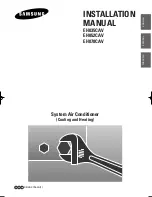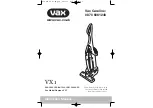
Connecting the Refrigerant Pipe
There are two refrigerant pipes of different diameters:
◆
A smaller one for the liquid refrigerant
◆
A larger one for the gas refrigerant
◆
The inside of copper tube must be clean & has no dust.
The connection procedure for the refrigerant pipes varies according to
the exit position of the pipes from the indoor unit, as seen when facing
the indoor in the “A” side.
◆
Liquid refrigerant port
◆
Gas refrigerant port
◆
Drain hose port
Remove the pinch pipe on the pipes and connect the assembly pipes to
each pipe, tightening the nuts, first manually and then with a torque
wrench, a spanner applying the following torque.
1
Must use insulator which is thick enough to cover the refrigerant tube to
protect the condensate water on the outside of pipe falling onto the floor
and the efficiency of the unit will be better.
2
Cut off any excess foam insulation.
3
Be sure that there must be no crack or wave on the bended area.
4
It would be necessary to double the insulation thickness(10mm or more)
to prevent condensation even on the insulator when if the installed area is
warm and humid.
5
If the pipes must be shortened refer to page 11.
N
N
N
N
o
o
o
o
tt
tt
e
e
e
e
Outer Diameter
Torque (kgf•cm)
6.35 mm (1/4")
140~170
9.52 mm (3/8")
250~280
12.70 mm (1/2")
380~420
15.88 mm (5/8")
440~480
19.05 mm (3/4")
990~1210
22.23 mm (7/8")
990~1210
E-
10
Liquid
refrigerant port
Drain hose
connection
port
Gas
refrigerant
port
Oil trap (Must be install
every 10m)
Oil trap (Must be install
every 10m)
Oil trap
(suction tube)
a. When the indoor unit is above the outdoor
unit
b. When the outdoor unit is above the indoor
unit
Indoor unit
Indoor unit
Outdoor unit
Radius
5cm
Outdoor unit
A
EH035EAV_IM_E_25807 3/24/06 7:21 PM Page 10











































